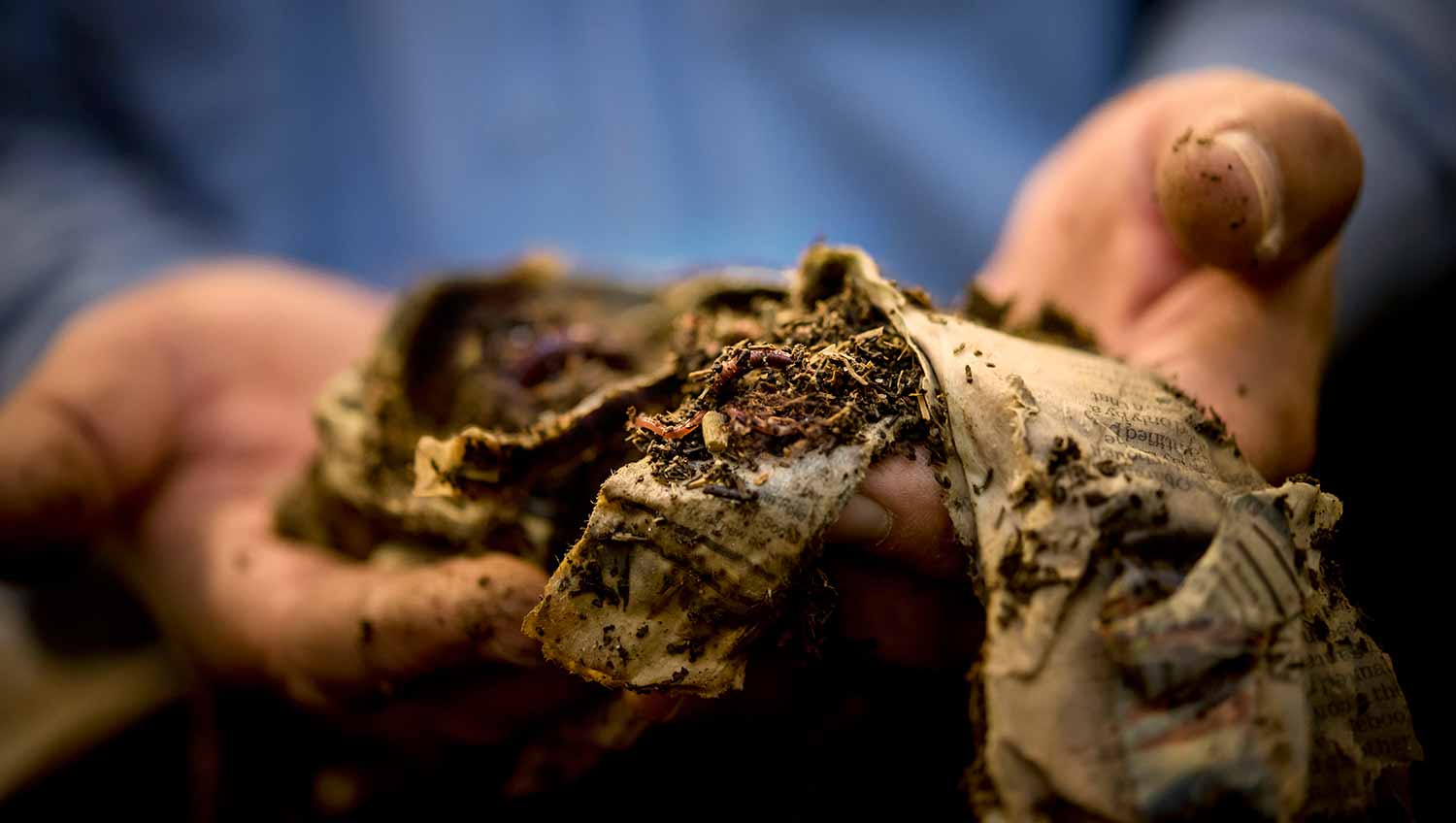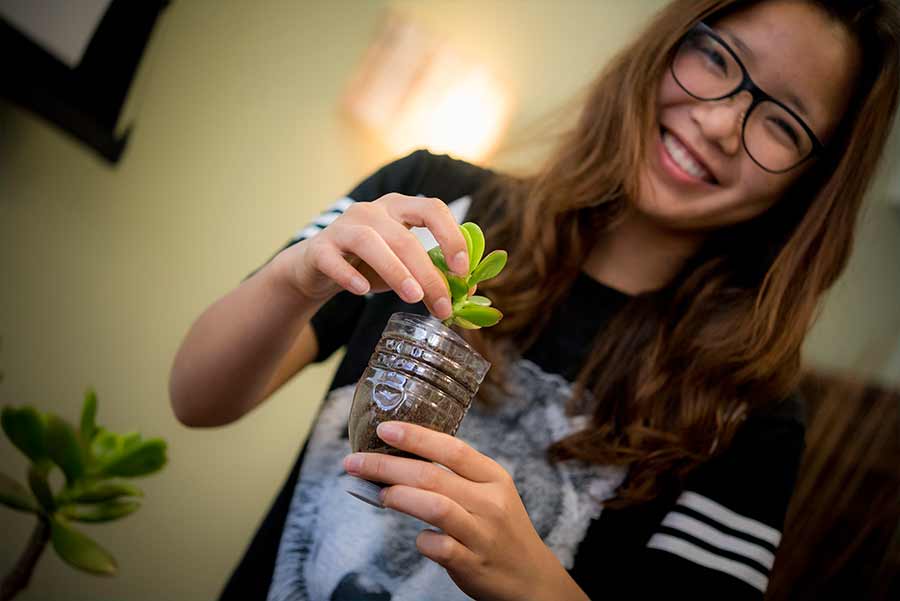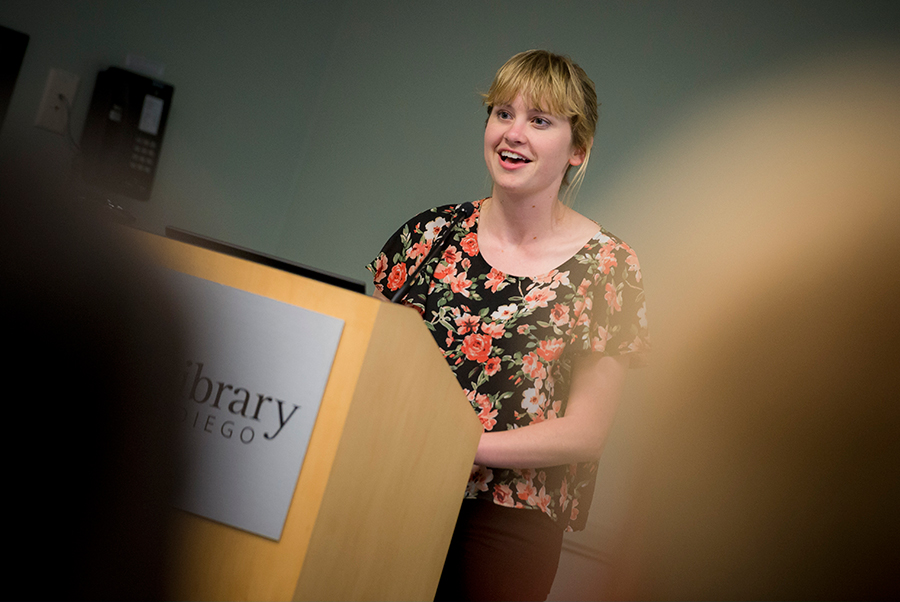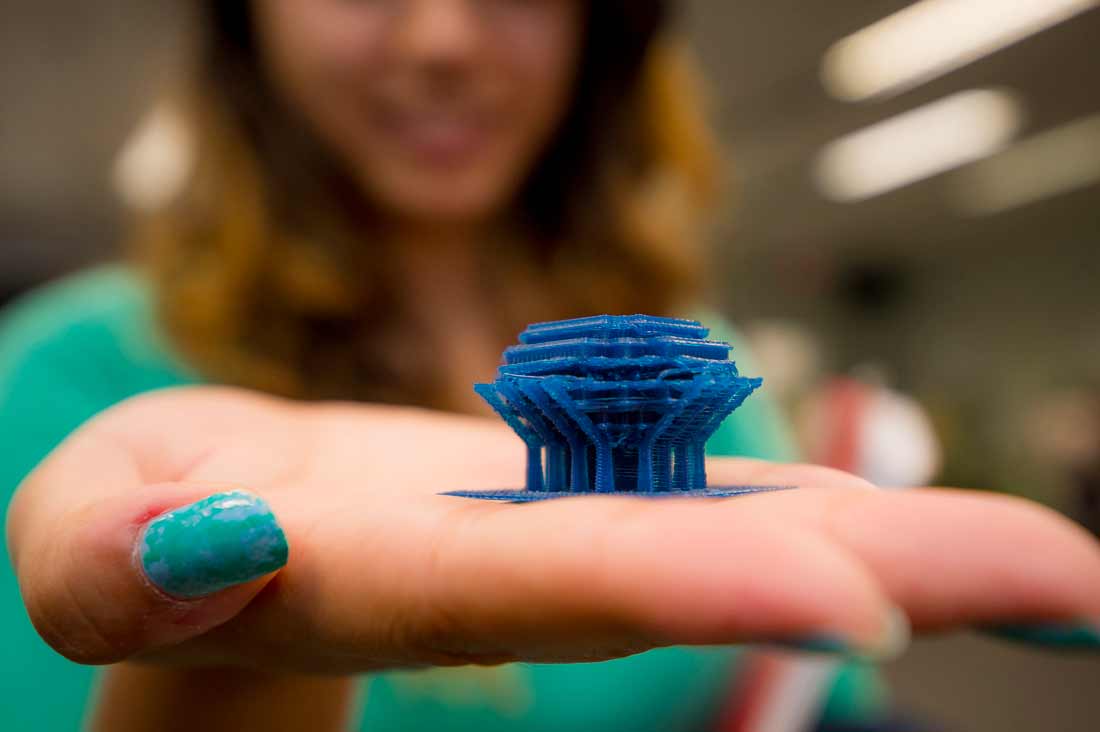
By:
- Christine Clark
Published Date
By:
- Christine Clark
Share This:

On Tuesday, members of the campus community participated in a workshop that taught participants how waste such as fruit and vegetable scraps, coffee grounds and stale bread can be used to make rich soil with a little help from red wiggler worms. Photos by Erik Jepsen/UC San Diego Publications
It’s Easy Being Green: Campus Learns Eco-Friendly Lifestyle Tips at Earth Week Events
They learned to compost, plant succulents in recycled water bottles, appreciate the unseen beauty beneath the sea and conserve water. UC San Diego’s Earth Week participants rolled up their sleeves for various events April 19-25 to learn how to live more sustainably, while demonstrating UC San Diego’s commitment to protecting the planet.

At the Zone, students got to show their artistic side with an “Art & Soul” event that showed participants how they could plant succulents in their own recyclable water bottle planter.
“It is thrilling to see the UC San Diego community take such an active role in this year’s Earth Week,” said Sara McKinstry, UC San Diego’s Sustainability Manager. “This is a great opportunity for people to learn that on an individual level, each of us has an impact on the environment, and we hope that by learning from Earth Week events, people will be inspired to make more sustainable choices in their daily lives.
“One of the major messages we’re trying to get across is the need to conserve water,” she added. “At many events, there is messaging and information on what individuals can do to fight the drought which is impacting our state and region.”
Cleaning up campus
Earth Week kicked off April 19 with the second annual campus cleanup, where some 40 members of the UC San Diego community helped maintain the health of the campus and its watershed by picking up trash and cigarette butts, all of which drain to La Jolla Shores, a state-designated Area of Special Biological Significance.
“Contrary to popular belief, cigarette butts do not decompose completely,” said Deborah Pino-Saballett, director of Health Promotion Services at UC San Diego, who participated in the cleanup. “In fact, cigarette butts and plastic filters of cigarettes continue to pollute the environment, are toxic to marine life and pose a fire risk. We’re trying to encourage those who smoke on the perimeters of campus to not litter.”
Pino-Saballett added that there are many resources for those who would like to quit and that individuals can learn more here.
On Monday, campus community members had a chance to learn more about diverting waste from landfills through the trash sort. Student “econauts” and staff from Housing, Dining and Hospitality dug through 1,000 pounds of trash to demonstrate how much of ordinary garbage is made up of recyclable materials.
The art of going green
At the Zone, students got to show their artistic side with an “Art & Soul” event that showed participants how they could plant succulents in their own recyclable water bottle planter.

At the "Using 3D Imaging to Shed Light on the Unseen Beauty Beneath the Sea" event, Scripps Institution of Oceanography student and artist Elizabeth Stringer and other Scripps researchers who discussed their work in ocean science and the environmental knowledge they've gained from using state-of-the-art optical tools to observe the underwater world of plankton.
Art was also at the center of an event held on Monday afternoon, “Using 3D Imaging to Shed Light on the Unseen Beauty Beneath the Sea.” The event featured Scripps Institution of Oceanography student and artist Elizabeth Stringer and other Scripps researchers who discussed their work in ocean science and the environmental knowledge they’ve gained from using state-of-the-art optical tools to observe the underwater world of plankton. “By collaborating with other researchers, I was inspired by their passion for marine science and was given insight into the massive, and specific, world that is zooplankton,” Stringer said. “These tiny, magnificent creatures have such a big footprint, not just in the oceans, but on our daily lives.”
Plankton, particularly zooplankton, is also the inspiration for a Library art installation, “My Meditations End in Reverie,” by Stringer, now on display through May. The instillation is a two-part exhibit located in the Seuss Room Foyer of the Geisel Library and in the Biomedical Library Building breezeway.
Earth worms make composting easy
On Tuesday, members of the campus community gathered at the Sustainability Resource Center to learn about a method of making compost that can be done in small spaces and more quickly than the traditional composting process. Approximately 20 people attended the event, which was hosted by the Staff Sustainability Network. The workshop taught participants how waste such as fruit and vegetable scraps, coffee grounds and stale bread can be used to make rich soil with a little help from red wiggler worms. In nature, red wiggler worms live at the very top of the soil and eat only decaying organic matter – they compost this material and thus replenish nutrients in the soil. Tuesday’s demonstration, taught by Sasha Doppelt, who works in the Center for Energy Research, showed how worms can do the same work in a worm bin – they eat the decaying organic food scraps, and, with the help of microorganisms, turn it into nutrient-rich compost. A worm bin can be placed on a balcony or in a closet, people can compost their kitchen waste all year long, thus reducing their carbon footprint as well as creating nutrient-rich compost for houseplants or gardens.
Doppelt, who has been using the same process at home for the past three years, showed how the process is sustainable and simple: Place worms in your worm bin along with some bedding material (shredded paper, coconut coir and dry leaves work great) and some kitchen scraps and water, and let them get to work. Worms can eat up to half of their body weight in food per day, so your feeding rate will depend on how many worms you have. You can then harvest the finished compost from the bottom and use it in your garden or on your houseplants.
Earth Day festivities

A student holds a 3D printed vegetable-based plastic Geisel Library at the DIY Makers Day event.
Earth Week event attendees learned other helpful tips on eco-friendly living at the DIY Makers Day event on Earth Day, April 22, at an event sponsored by the UC San Diego Library.Makers Day taught participants how to “go green” by repurposing sustainable, non-toxic and recyclable materials from their everyday lives. The goal of the event was for participants to walk away knowing how easy it is to make eco-friendly products and reuse consumables at home on a daily basis, ultimately saving resources and benefitting the environment.
Also on Earth Day, the campus was invited to celebrate with student organizations, campus departments and other organizations to learn how to live more sustainably at the Earth Day Fair.
“The Earth Day Fair is a great celebration of the incredible work faculty, staff and students do to make the university, and their own lives, more sustainable,” added McKinstry. “We have music, games, give-aways, and great ideas anyone could take back to the office or home to be more sustainable. The fair shows that being more sustainable is easy and fun.”
Share This:
You May Also Like
Stay in the Know
Keep up with all the latest from UC San Diego. Subscribe to the newsletter today.


